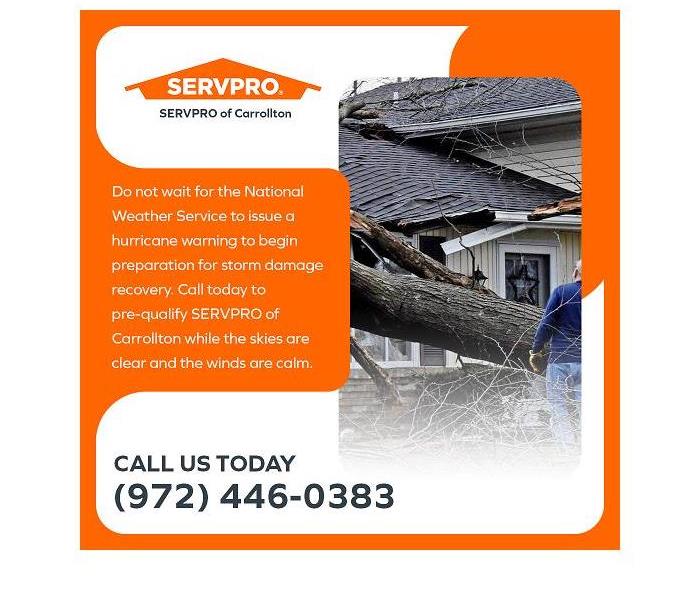Important Hurricane Terms to Know to Prepare for Storm, Wind, and Water Damage
7/22/2022 (Permalink)
Blog Summary: SERVPRO of Carrollton outlines common hurricane terminology that Farmers Branch, TX, residents need to be familiar with during the 2022 storm season.
SERVPRO of Carrollton wants homeowners and businesses to understand that when a storm or flood causes water damage, mold cleanup is crucial to prevent further structural damage and to maintain a safe, healthy environment in the home or business. The 2022 hurricane season will very likely bring storm, water, and flood damage to many communities across the United States. Knowledge of the terminology used by meteorologists and emergency personnel can help homeowners and businesses in the Farmers Branch, TX, area prepare for an approaching storm.
Hurricane Terminology: A Helpful Resource for Preparing for Severe Weather
June 1 through November 30 marks the boundaries of the Atlantic hurricane season. From the Gulf Coast of Texas to the Eastern seaboard, the scientists of the National Oceanic and Atmospheric Administration (NOAA) are studying a variety of observational and measurement instruments and looking for signs of tropical storms, tropical depressions, and hurricanes. Long before a hurricane makes landfall with its devastating winds, destructive storm surge, and torrential rains, tens of millions of people in its potentially deadly path have been made aware of the situation, advised to take appropriate safety measures, and warned of the impending dangers.
An understanding of weather and storm terminology is crucial for preparation, safety, and survival. The list below includes some of the most common terms used by the weather experts at NOAA and local emergency and rescue personnel. One of the best ways to stay informed is to invest in at least two weather band radios, each with multiple power sources, including electricity, batteries, solar power, and a hand crank generator.
#1. Cyclone
A cyclone is a meteorological term describing a large air mass rotating around a strong center of low atmospheric pressure. A cyclone spins counterclockwise in the Northern Hemisphere and clockwise below the equator. The word “cyclone” originates from the Greek word kukloma, which refers to a wheel or a coiled snake, and the Greek root of the word is kuklos, meaning circle or ring. Fittingly, the distinguishing feature of a cyclone is the rotation of air mass.
#2. Invest
When a weather system captures the attention of a tropical cyclone forecast center, i.e., a research station, the center will “invest” its resources in collecting specialized information that will aid in forecasting the path and strength of the weather event.
#3. Tropical depression
The general public often misunderstands the difference between a tropical depression and other weather systems, particularly a tropical storm. A tropical depression is a cyclone (rotating weather system) with maximum sustained surface wind speeds of 38 mph or less.
#4. Tropical storm
Tropical storms have maximum sustained surface wind speeds ranging from 39 mph to 73 mph. The magnitude of this type of cyclone is intense and can cause widespread damage.
#5. Hurricane
A hurricane is a rotating air mass with a clearly defined eye or vortex. The maximum sustained surface wind speed is 74 mph or greater.
An understanding of the five categories of hurricanes provides insight into the intensity of the storm when it makes landfall.
Category 1: 74-95 mph
Category 2: 96-110 mph
Category 3: 111-129 mph
Category 4: 130-156 mph
Category 5: 157 mph or higher
Category 3 or higher cyclones are considered major hurricanes. Category 4 and Category 5 hurricanes cause massive property damage and devastation. Loss of life may be high, such as the Great Galveston Hurricane of 1900, which took an estimated 8,000 lives. In August of 2005, Hurricane Katrina, with sustained wind speeds of 175 mph, slammed into New Orleans, leaving over 1,800 deaths in its wake.
#6. Landfall
A hurricane makes landfall when the storm’s eye or center impacts the coastline. However, the effects of the storm may be felt long before the center intersects the coastline.
#7. Storm surge
Storm surge refers to the rise in sea level caused by a hurricane and often causes massive flooding along the coastline. Hurricane Harvey recorded a storm surge of 8.4 feet, while Hurricane Ike topped out at 12.79 feet. Hurricane Katrina produced a storm surge of 27.8 feet. This nearly 30-foot wall of water explains the massive devastation and loss of life caused by the storm. A misconception about the destructive power of storm surge flooding can be catastrophic and life-threatening. For example, a structure may survive 111 mph winds from a Category 3 hurricane but be demolished by the storm surge.
#8. Hurricane watch
This weather bulletin announces the possibility of sustained winds of 74 mph or higher. The NWS issues the announcement 48 hours in advance to give people living in the affected areas time to prepare or evacuate.
#9. Hurricane warning
This weather bulletin announces that sustained winds of 74 mph or higher are expected. A warning refers to an actual danger level rather than a potential one. The NWS issues the alert 36 hours in advance of the high winds, and the warning may stay in effect if a dangerous storm surge is forecast, even if wind speeds drop below 74 mph.
Do not wait for the National Weather Service to issue a hurricane warning to begin preparation for storm damage recovery. Call today to pre-qualify SERVPRO of Carrollton while the skies are clear and the winds are calm.
To learn more about water damage cleanup for storm-damaged homes and businesses in Farmers Branch, TX, call SERVPRO of Carrollton at (972) 446-0383. The office can also be contacted by email at office@SERVPRO10952.com

 24/7 Emergency Service
24/7 Emergency Service
